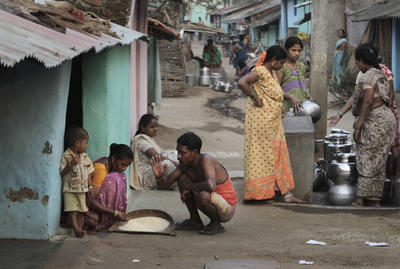A poverty line has a number of uses. First, it defines a certain minimum consumption basket. When India was very poor, this minimum was specified in terms of the food necessary for survival, with the poverty line representing the income required — after adjusting for inflation — to be able to afford a daily energy consumption of 2100–2400 calories.
Second, it can also define a minimum socially acceptable standard of living. This is a relative concept, rising with a society’s general standard of living; for example, the poverty line is higher in more affluent countries. The current international standard is US$1.25 per day, adjusted for the purchasing power of the particular local currency.
In India, as per capita incomes have increased, there has been a rise in the socially acceptable minimum standard of living — and the Tendulkar Committee recalculated the poverty line to include a basic level of shelter, clothing and medical expenditure. The Indian government’s recent poverty measure estimated that Rs28 (US$0.56) per day, per person in urban areas and Rs22.50 (US$0.44) in rural areas is sufficient to reach this new minimum standard, after correcting for inflation. These values are quite close to the Indian rupee’s purchasing power parity compared to the US dollar.
Third, a poverty line measures how many people rise above it over a period of time. For this purpose, the definition of the poverty line should not change across the two points of time being compared. Based on this, India’s Planning Commission correctly used the Tendulkar Committee’s definition to estimate that the poverty ratio registered a decline from 37.2 per cent in 2004–05 to 29.8 per cent in 2009–10. A higher poverty line may have yielded a larger percentage of poor, but would still have shown a decline over time.
The error that the Planning Commission made, however, was in framing its expenditure calculations. The Planning Commission used the norm of expenditure per person, per day, whereas Indians largely think in terms of monthly family budgets. While the daily rupee figure may seem absurdly low, when translated into a monthly budget for a four-person family, it works out to a more tolerable Rs4000-plus (US$78). While that is still very low, the very poor in India do manage with such incomes. Also, pooling generates more purchasing power.
The other reason for the chorus of criticism against the Planning Commission’s estimate is that socially acceptable standards of living have gone up in a more affluent India. The poor should be able to not only afford facilities that help them to rise above poverty, but also avoid the shocks that push them below the poverty line. This can be achieved through training and education for their children, and various types of insurance cover, including medical.
Fourth, a poverty line may be used as an entitlement for government programs that deliver the above types of support. Since those hovering just above a minimum standard also stand the risk of being pushed below it, entitlements should be made available for a larger percentage of Indians.
The post-budget debate on the government deficits has been equally misplaced, with deficits trashed regardless of their economic implications. But these criticisms largely miss the point. First, the fiscal deficit measures the net demand from the Indian government — its total expenditures in excess of revenue. It is also the government’s borrowing requirement. There is some scope for the latter since domestic savings in India are high. A deficit is worrying only if it worsens excess demand and is so large that the government’s debt is unsustainable. At the current juncture, there is no excess demand, as output is below potential.
Second, the government’s own debt is reasonable and, given India’s higher trend growth rate, is certainly not unsustainable. The central government’s finances also improved with the fiscal responsibility legislation. But every such law has to have an escape clause, and the global financial crisis and the oil price shocks that followed were adequate reasons for triggering these clauses.
The current deficit levels are not worrying if the government recommits to a new fiscal consolidation path, which it has in the recent budget. In addition, taxes have been raised and expenditure growth has fallen compared to the levels they reached during the global financial crisis on account of various fiscal stimulus measures. There is also an attempt to increase the share of capital expenditure to improve supply response. The lesson from all this is that statistics can abet illusions, unless properly understood and used.
Ashima Goyal is Professor of Economics at the Indira Gandhi Institute of Development Research, Mumbai.
This article was first published here at The Hindu Business Line.

